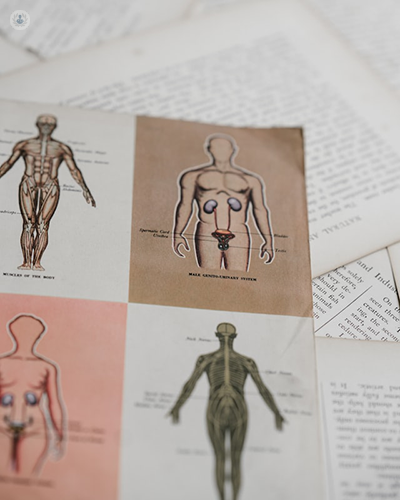What is involved in endourological treatment?
Written in association with:In this in-depth guide to the many applications of endourology, highly respected consultant urologist Mr Sudhanshu Chitale shares his expert insight on commonly performed procedures used to manage prostate enlargement and kidney stones, amongst many other conditions.

What is involved in endourological treatment?
Endourology of the lower urinary tract involves:
- Urethrotomy - management of narrowings in the urethra by opening up of the stricture
- Transurethral resection of the prostate with an endoscope (TURP)
- Bladder tumour removal, transurethral resection of the bladder tumour (TURBT)
- Endoscopic litholapaxy – an endoscopic procedure to break and remove a bladder stone
Each of these procedures is performed through the natural urethral orifice, without having to cut open any part of the body or urinary system whatsoever.
Endourology of the upper urinary tract includes other types of procedure, namely:
- Ureteroscopy
- Percutaneous nephrolithotomy (PCNL)
Ureteroscopy
In ureteroscopy, a similar but smaller camera is passed up the ureter (tube draining the urine from the kidney into the bladder) and can be used to help break and remove a stone blocking the ureter, having already dropped from the kidney into the ureter.
In these cases, patients will usually present to us with renal colic, which is kidney pain caused by a stone coming down the ureter and partly or fully blocking the kidney. This causes extreme pain (8-10/10 on the pain scale), which can often require treatment with morphine. With an endoscope going up the ureter, these stones can easily be removed, either intact or after breaking it into pieces.
In the past, the same thing was done with an open operation, which required a large incision (of around six inches) on the side of the abdomen or the flank, and the ureter cut open in order to take the stone out in one piece. This is now a historical procedure.
Similarly, in cases of actual kidney stones, we can now go up the ureter into the kidney and break or blast the stone. Stones such as these can be treated in this way when the stone size is up to 10-15 millimetres, although sometimes several sittings are needed.
Percutaneous nephrolithotomy (PCNL)
If the stone happens to be larger than 15-20 millimetres, however, the easier and quicker approach would be an endourological operation performed percutaneously (going through the skin) from the back into the kidney directly. This allows us to blast and break up the stone so it can be removed in one go, rather than undertaking the same procedure requiring more than one sitting as could become the case with an endoluminal endourological procedure using a flexible or wriggly rather than a straight or rigid camera passed up the ureter into the kidney.
What endourological procedures are commonly performed?
Percutaneous nephrolithotomy (PCNL) is an extraluminal percutaneous endourological procedure, meaning we go through the skin of the back, puncturing and making an access track into the kidney in order to break and remove a stone.
Ureterorenoscopy, uretero-renoscopy and laser destruction of the stone is a procedure carried out by going up the natural orifice, down the urethra, through the bladder, and up the ureter and into the kidney to break and remove a stone.
Endoscopic litholapaxy is a procedure in which a stone in the bladder is broken up and taken out through the natural orifice (urethra or waterpipe) without opening the bladder.
Procedures such as transurethral resection of a bladder tumour (TURBT) and transurethral resection of prostate (TURP) are also performed by passing the cystoscope (rigid camera) down the natural orifice or the urethra.
Additionally, there are a number of other endoscopic minimally invasive procedures for the prostate, which have developed over the last twenty years. These include UroLift or prostate lift, which is a stapling operation to separate the two lobes of the prostate and pull them apart by using a stapler device. This is a simple procedure and can be performed under local anaesthesia or sedation as a day case and patient leaves the hospital without a catheter.
Other procedures, which serve as alternatives to traditional TURP include:
- Holmium laser ablation of prostate (HoLAP)
- Holmium laser enucleation of prostate (HoLEP)
- Rezum steam ablation of the prostate
- Aqua-ablation of prostate
These are the endourological procedures performed by lower urinary tract endourologists.
Aqua ablation procedure for the prostate is performed with a transrectal probe up the back passage to ablate the prostate with ultrasound energy and a cystoscope to look down the urethra. This allows us to see what the endourological surgeon has achieved by ablating the prostate before completing the procedure with a tidying up job performed down the urethra as appropriate.
In terms of laparoscopic and robot-assisted procedures, Upper urinary tract endourologists perform procedures down an unnatural orifice or keyholes made into the patients’s abdomen or back (flank) including:
- Laparoscopic robot-assisted nephrectomy for cancer or non-cancer conditions
- Laparoscopic robot-assisted partial nephrectomy for kidney cancer
- Laparoscopic robot-assisted nephroureterectomy for cancer of the kidney or ureter
- Laparoscopic robot-assisted radical prostatectomy for prostate cancer
- Laparoscopic robot-assisted cystectomy and diversion for bladder cancer
Who is suitable for treatment with endourological procedures?
In the majority of cases, patients presenting with urological symptoms related to urological conditions would be suitable for an endourological procedure. Very few patients nowadays are unsuitable for endourological procedures and therefore the surgeon would have to resort to a traditional procedure performed via an open approach.
Most urological pathologies that men, women or children present with can now be dealt with using endourological procedures via either an endoluminal or intraluminal approach down the natural orifice or extraluminal or percutaneous procedure performed down a keyhole or unnatural orifice.
If you wish to schedule a consultation with Mr Chitale, you can do so by visiting his Top Doctors profile.


